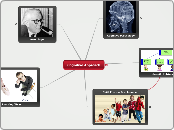Cognitive Approach

Cognitive Psychology
Studies human cognition
Attempts to answer how and why people learn
Remembering general meanings
rather than the word by word
information
Effects in behavior
Developed in base
of the advances in:
Gestalt
Gestalt
A structure, configuration, or pattern of physical, biological, or psychological phenomena so integrated as to constitute a functional unit with properties not derivable by summation of its parts.
Gestalt Psychology
In the Berlin School is a theory of mind and brain positing; the operational principle of Gestalt is that the brain is holistic, parallel, and analog, with self-organizing tendencies
Emergence is the process of complex pattern formation from simpler rules.
Reification is the constructive or generative aspect of perception.
Multistability (or multistable perception) is the tendency of ambiguous perceptual experiences to pop back and forth unstably between two or more alternative interpretations.
Invariance is the property of perception whereby simple geometrical objects are recognized independent of rotation, translation, and scale.
Developmental and comparative psychology
Computer Science
Information processing
Part of cognitice science
Contemporary Cognitive Thoery
Developmental
Jean Piaget
representional thought
contruction of mental models of the world
Information-Processing
Human mind is the equivalent
of a complex computer system

Genetic Epistemology
Timetable established by nature
for the development of children's
ability to think
Stages
First Stage
Sensimotor Stage
0-2 years old
Mastering physical reflexes
Aware of himself as an individual
Objects are a separate and permanent
Second Stage
Preoperational
2-6 or 7 years old
Manipulate the the enviroment
though thought
Represent objects by words
Manipulate them mentally
Third Stage
Concrete Operational
7-11 or 12
Beginnigs of logic in the thought process
Classification by similarities and differences
Concepts of time and number
Fourth Stage
Formal Operations
12-Adulthood
Orderliness of thinking
Mastering of logical thought
More flexible kind of
mental experimentaion
Manipulate abstract ideas
Make hypothesis
See the implications of their
thinking and that of others
Reevaluation of the older ideas of a child
Not only stimili were needed
At the correct time
Teacher was a guide
The child discovered
the world by himself
Child Process Development

Growth of perceptual, emotional, intellectual,
and behavioral capabilities and funtioning
during childhoold
Childhood is from when you adquire
language (1-2 yo) to adolescence (12-13)
Development
Speech starts
2 years
Continually growing vocabulary
Use of words in combination
Start to understand
grammar and syntax
3 years
Small sentences
4 years
Use adult-like sentences
5-6 years
Mastery of complex rules
of grammar and meaning
Symbolic Thought and Language
manipulate their enviroment
Mental operations using symbols,
concepts and ideas
Beginings of logic
Come at 7 to 12 years old
Memory capacity increses
Awareness of their emotions
Empathy
Moral sense
Identity
Sex-role identity
Based in gender
By age of 3
End of childhood
Puberty
Physical and emotional changes
Logical processes of adults

Jean Piaget
Swiss Psychologist
Major figure of the 20th century
in delopmental psychology
Started as a zoogist
First to study how children
adquired understanding
Administed reading tests to school children
Explored their rasoning process
The mind of the child evolves
though a series of set stages
Creating and recreating
his model of reality
Integrating simpler concepts
into more complex ones at
at each stage
Argued in favor of genetic epistemology
Conclusions though observation
and conversations with children
Works
The Language and
Thought of the Child
(1923)

Judgement and Reasoning
in the Child (1924)
The Origins of Intelligence
in Children (1948)
Series of books dealing
with children’s conceptions
of time, space, physical
causality, movement and
speed, and the world
in general.

Learning Ways
Sensory
Sensory learners prefer concrete, practical, and procedural information. They look for the facts.
Intuitive
Intuitive learners prefer conceptual, innovative, and theoretical information. They look for the meaning.
Visual
Visual learners prefer graphs, pictures, and diagrams. They look for visual representations of information.
Verbal
Verbal learners prefer to hear or read information. They look for explanations with words.
Active
Active learners prefer to manipulate objects, do physical experiments, and learn by trying. They enjoy working in groups to figure out problems.
Reflective
Reflective learners prefer to think things through, to evaluate options, and learn by analysis. They enjoy figuring out a problem on their own.
Sequential
Sequential learners prefer to have information presented linearly and in an orderly manner. They put together the details in order to understand the big picture emerges.
Global
Global learners prefer a holistic and systematic approach. They see the big picture first and then fill in the details.
